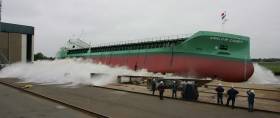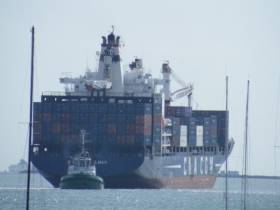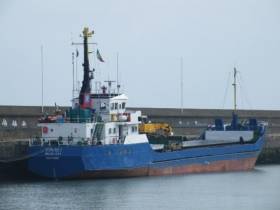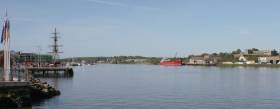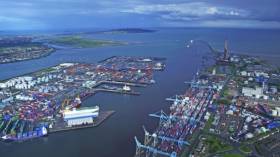Displaying items by tag: Ports and Shipping News
Scottish South-West Port of Ayr Wins Top ABP Award
#PortAward - The Scottish south-west Port of Ayr, (south of Troon, see ferry report) part of the large UK ports owned group, ABP, won the top accolade at this year’s company chairman’s awards, writes Jehan Ashmore.
The award is the ‘Oscars’ for staff of the ABP (Associated British Ports), which operates 21 ports across Scotland, England and Wales. Among cargoes handled are aggregates, animal feed, salt, sand and forest products. In this trade alone around 200,000 tonnes are handled annually.
An example of a general cargoship using the Ayrshire port is shown in the above photo of Wilson Gdynia (2,506grt) operated by Norwegian based Wilson Group. The vessel berthed at North Quay, on the River Ayr. A fleetmate, Wilson Dublin (2,452grt) became the largest ship to dock in Dingle Harbour, where it loaded sandstone from west Kerry last year for use in UK roads construction.
The Port of Ayr not only won the Customer Service Award in the UK-wide port network, but took the Group Award as well, the biggest honour at the ceremony.
The group were nominated by port manager Stuart Cresswell who praised his team for their focus on continuing operational improvement and, in particular, for their service to fertiliser specialist Yara.
Yara operates from seven locations in the UK, including the Port of Ayr which it ranked as its top port in 2015 in terms of customer service. Simon Barley, Supply Chain Operations Manager for Yara UK and Ireland, said: “Ayr comes out on top as Yara’s best import terminal in the UK.
Arklow's Second C Class Launch Date Announced
#SecondCclass - The second of 10 newbuilds built to a new design for Arklow Shipping is to be launched next month, writes Jehan Ashmore.
Yard No. 425 Arklow Cape is to be launched on 21 October from the Ferus Smit facility in the Netherlands, the first to carry that 'C' themed name for the shipowner formed in 1966.
The yard at Westerbroek is where leadship, Arklow Cadet first contacted the water in June for Arklow Shipping Ltd.
With a maximized hold volume of 220.000 cft, Arklow Cape has a 5,000dwt cargo carrying capacity and is under the 3000 gross tons limit.
The single hold cargsoship has an 1A ice-class notation and is to be propelled by a 1740 kW MaK engine with a single ducted propeller.
Delivery of the second sister is scheduled for November.
Arklow’s continued newbuild programme includes orders with the V class series albeit from another Dutch yard, Royal Bodewes. Again this order is for 10 vessels, but for Arklow Nederland B.V.
More than €7.6bn in Trade Handled by Shannon Foynes Port Company
#TradeReport - More than €7 billion in trade every year was handled by Shannon Foynes Port Company, according to a report commissioned by the State company that runs mid-western harbour, writes The Irish Times.
Research by W2 Consulting, based on 2014 figures from the port itself and 31 companies using it, shows that it is worth €1.9 billion to the wider economy and handles €7.6 billion in trade annually.
It also shows that Shannon Foynes Port Company and its customers plan to spend €277 million between them over the five years to 2019, which will support 3,372 jobs in the region.
The port company intends to spend €130 million on an expansion plan, dubbed Vision 2041 , that will exploit advantages such as its deep water and sheltered harbours to develop an international trade hub there.
For much more including video featuring Chief Executive, Pat Keating, click here.
#More45ftUnits - Irish Continental Group's (ICG) Eucon, one of three container divisons, which operates Ireland-France/Belgium 'feeder' services, have increased their 45ft unit capacity.
The 300 new 45ft units were manufactured at the CIMC factory in Nantong, China.
This latest batch is a continuation of the container fleet renewal program over the last 4 years which has seen the addition of 1,100 new 45ft units to the fleet since July 2012.
The new units will be incorporated into the container fleet from September 2016. The boost in capacity will further improve the overall quality of services offered to the 'feeder' services.
Eucon has a container fleet operated by eight vessels.
#IEAonBrexit - Irish Exporters Association members in which an overwhelming 92% of them believe the decision by the UK to leave the European Union will have a harmful effect on their business.
UTV News says the IEA published the results of their recent survey of members on Thursday.
They say that even though the UK has yet to leave the EU, they are still being impacted by the weakening of Sterling, which has fallen against the Euro by 19% since mid-November and by 9% since the vote.
Overall, 92% of members said they think the vote will have a harmful impact on Irish exporters. For more, click here
Wicklow Regular Involved in Scottish Ferryport Redevelopment
#CargoTerminal - A Wicklow Port regular, cargoship Burhou I, has been involved in assisting construction of a new ferryport, away from routine ‘bread and butter’ cargoes such as round timber, writes Jehan Ashmore.
Among the various work related vessels at CalMac’s ferry terminal redevelopment at Brodick on the Isle of Arran, has involved the 647 tonnes general cargoship coaster, operated by Great Glen Shipping.
The veteran vessel dating from 1978, arrived loaded with primary rock armour for the project to be completed in summer 2017. The cargo was loaded at Furnace, Argyll across the Forth of Clyde.
Burhou 1 which normally discharges round timber (logs) cargoes from Scotland to Wicklow, had in March been detained by Port State Control for a single technical deficiency. After shifting berths to the East Pier, repairs were made to the 58m long, Belize City registered coaster. This was to satisfy PSC clearance prior to granting departure.
This evening, Burhou 1 is heading through the North Channel bound for Lochaline, Scotland, after a call to Passage West, Cork Harbour. This is a privately owned wharf, which regularly sees timber and scrap-metal cargoes as reported by Afloat back in 2011 that reflected on old Irish shipping firms.
Heading also northbound is another timber trader, Scot Ranger (1997/2,260gt) registered at Inverness, which too called to Wicklow. Shipowners, Scot Line, are regular clients of the east coast port where the 86m vessel arrived from Newport, south Wales to berth at Packet Quay.
Both vessels this evening are abreast of each other off the Co. Antrim coast.
One of eight in the fleet, Scot Ranger, is regularly engaged in supplying Swedish packaged timber products from Varberg to dedicated terminals in the UK and to Irish ports. Following the call to Wicklow, last night the 86m vessel anchored off Dublin Bay awaiting orders. She is now heading to Varberg.
Port of New Ross to Dispose of Terminal Site
#TerminalSite - The Port of New Ross on the River Barrow, has been a hub for dry and liquid bulk traffic and project cargoes for many years. In 2015, total trade through the Co. Wexford port exceeded 286,000 tonnes.
In order to optimise the use of existing port infrastructure, the port company wishes to dispose of a terminal within the port estate, which is situated in the townland of Marshmeadows, downriver of New Ross.
On behalf of the port company, the Marine Institute is inviting expressions of interest in acquiring the facility. The terminal comprises a jetty and adjoining lands measuring approximately 2 hectares.
New 'Maritime Knowledge Hub' Opens Across the Irish Sea
#NewMaritimeHub - A newly opened ‘Maritime Knowledge Hub’ to drive growth in the UK maritime sector has been opened in Birkenhead, Liverpool City Region.
The hub, based near Cammell Laird shipyard is celebrating the formal completion of its recent fit-out and is now planning a busy agenda of events, seminars, training and networking.
Completion of Phase 1 of the Maritime Knowledge Hub is a joint venture between Mersey Maritime, Liverpool John Moores University (LJMU) and Wirral Council on behalf of the Liverpool City Region Combined Authority. The fit-out was completed by Wirral based Beech Group, which specialises in demolition, but have a refurbishment division.
The facilities include serviced business start-up space and support, a conference space and a state-of-the-art facility to help manufacturers design, test and build products or services. The partners will also aim to market LJMU’s fully immersive ship’s bridge simulator training suite to new domestic and global markets.
Mersey Maritime CEO Chris Shirling-Rooke said the hub wants to engage with small business owners as ‘the backbone of the economy’ from across the region.
“We have a clear message to businesses – join Mersey Maritime and grow,” he said. “The hub is designed to galvanise the opportunities for UK businesses in the maritime industry by following the trail blazed by businesses like Peel, Bibby and Cammell Laird. Already the sector drives 13pc of Merseyside’s GDP and is worth more than £3billion. That figure is set to grow with the maritime industry globally worth more than £3000billion. We just need a fraction of that business to fuel our growth. The hub is aimed at firms already trading in maritime and also those who see opportunity to diversify.”
Professor Ahmed Al-Shamma’a, Executive Dean of the Faculty of Engineering and Technology at LJMU, said: “The Maritime Knowledge Hub represents an exciting first step in the partnership between LJMU and Mersey Maritime.The re-fit programme has given us a base from which to provide new and niche activities that can bring together business and academia, providing local firms and wider industry with the skilled staff they need to grow and compete.”
Beech group Managing Director Chris Wainwright said: “Beech’s involvement as main contractor in the fit-out of Phase 1 of the Maritime Knowledge Hub has given us a high profile opportunity to showcase the range of services we can provide. The hub will be a magnet for firms from across the region who are looking to grow their business, upskill their people and gain access to industry supply chains,”
He added: “Beech Group is exactly the type of business that can benefit from membership of Mersey Maritime. We are an ambitious, growing SME with a range of services that are supplied into the maritime and related sectors. Membership of Mersey Maritime has helped open doors and our client list now includes Cammell Laird, Liverpool John Moores University and Essar.”
Mr Shirling-Rooke said by joining Mersey Maritime its team can help businesses engage with the hub and identify how to grow and diversify into the maritime industry.
“We can introduce businesses with useful contacts through the hub to help them see how they could become part of the supply chain - and the beauty of the maritime sector is its breadth,” he said. “All types and sizes of companies can expand within it, from purely marine businesses to professional services, construction, transport, engineering and hospitality. In addition, maritime presents glittering opportunities for exports sales and a key role of the hub will be to help local businesses find overseas customers and clients. So we urge ambitious companies, large and small, that want help and support to join Mersey Maritime and grow.”
Mr Shirling-Rooke said the hub will focus on Merseyside’s core strengths in manufacturing, research and development, innovation and education and training.
#IrishUKTrade - Enterprise Ireland are to seek its clients to be less reliant on the UK markets. The Irish Times writes the reduction will cut the proportion of their exports that go to Britain by about seven percentage points over the next five years, following the UK’s decision to leave the EU.
The agency responsible for helping Irish companies export to international markets, saw exports to the UK increase last year by 12 per cent to €7.5 billion.
The UK remains the Republic’s largest export market, though exports there as a proportion of Enterprise Ireland’s total client exports has declined from 45 per cent in 2005 to 37 per cent in 2015.
Enterprise Ireland UK and northern Europe director Marina Donohoe said on Monday “it would certainly be the intention” to reduce the figure further over the next number of years to mitigate the fallout from the referendum result.
For more on this story, click here.
#RMSroyalty - RMS St. Helena which Royal Family member Princes Anne visited as previously reported during the ships historic visit to London, is to depart later today on a farewell voyage from the UK to St. Helena Island in the South Atlantic, writes Jehan Ashmore.
For more than a quarter of a century, the 159 passenger ship custom-built for St. Helena Line to bring essential supplies of cargo to St Helenian’s, however is to be decommissioned. The Scottish built ship pf 6,767 gross tonnage is to be replacement by German containership contracted to AW Ship Management that currently includes operations of RMS St. Helena.
In addition a new airport, a first for St. Helena, the British Overseas Territory of 47 square miles, is yet to open and this has extended operation of voyages to September.
The Princess recalled her own visit to the Island on the RMS in 2002, that was before the St. Helena Line vessel changed routes from the UK and now she sails to and from Cape Town, South Africa, a distance of 1,200 miles taking five days. She highlighted the crucial role RMS played in the lives of the islanders and she ended by wishing everyone a successful voyage back to St Helena.
St. Helena Government’s UK representative, Kedell Worboys MBE, commented: “What makes the RMS special? For the past 26 years she has provided the lifeline to the people of St Helena and Ascension – carrying food, medical supplies, building materials, and of course the mail. She is one of only four remaining Royal Mail Ships and the last working one. “She is quite simply an extension to St Helena, part of our family.”
Guests enjoyed a reception on the Sun Deck with spectacular vistas of the Pool of London while moored on the Thames alongside HMS Belfast, a WW2 battle cruiser and a backdrop to include the Tower of London and Tower Bridge. The opportunity was taken by many to acknowledge the dedication of the officers and crew.
Captain Andrew Greentree added: “It was a great honour and privilege to welcome HRH The Princess Royal on board the RMS St Helena and to be the Captain whose crew prepared the ship well for this historic and memorable event. The officers and crew greatly appreciate HRH visiting the ship and taking a photograph with them.”
On completion of a four-day call visit in the UK capital, RMS St. Helena departed on Friday 22nm miles downriver to Tilbury Docks, London Cruise Terminal.
The next day, due to the ship's unique career and final call to the UK, some 600 members of the public eagerly boarded for a pre-booked tour of the ship. Having loaded cargo in recent days, passengers will board today at the Landing Stage for the ‘RMS’ final voyage from the UK.



























